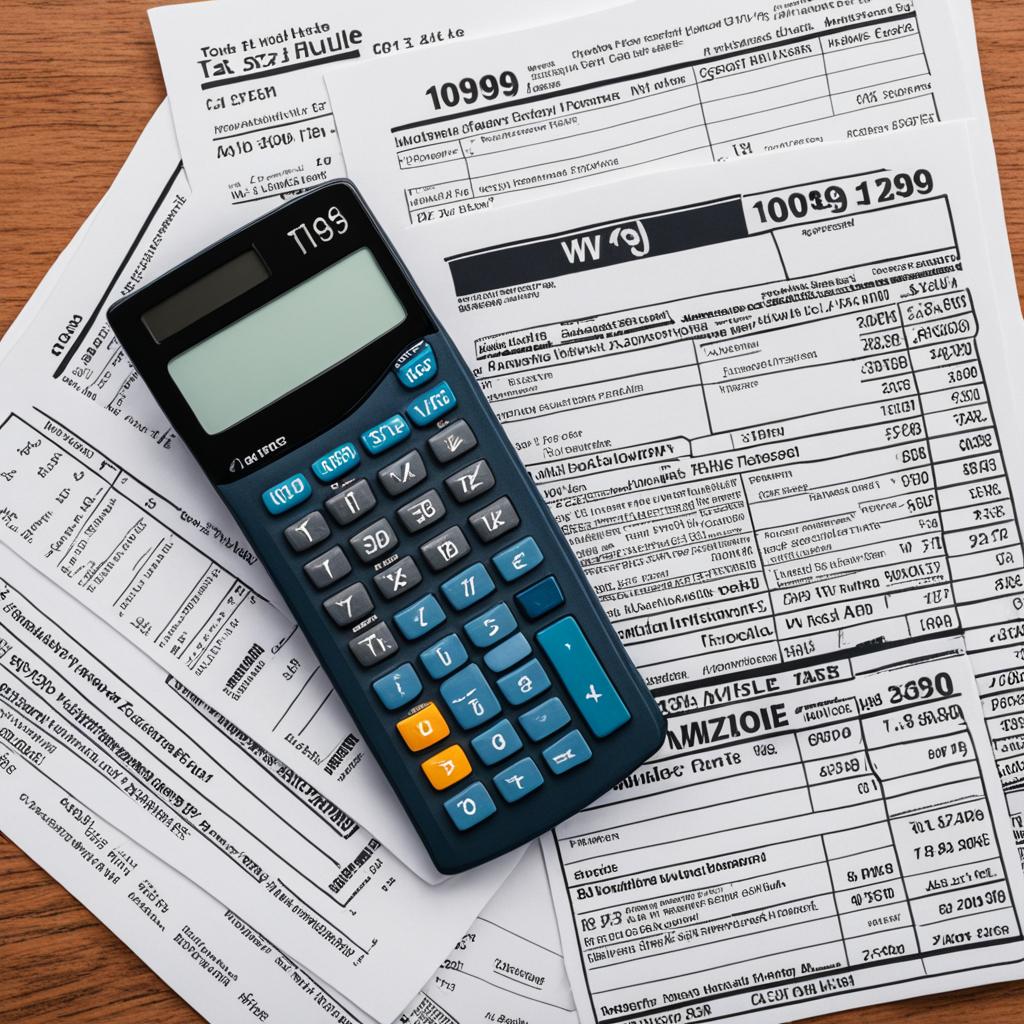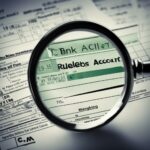Being an entrepreneur and having a side hustle can be an exciting way to earn extra income and pursue your passions. Whether you’re freelancing, selling products online, or offering services, it’s important to understand the tax implications of your side hustle. In this guide, I’ll provide you with valuable insights and tips on how to navigate the world of side hustle taxes and ensure you’re meeting your obligations while maximizing your tax benefits.
Key Takeaways:
- Income from your side hustle is subject to taxes, regardless of the amount.
- Reporting your side hustle income is crucial, even if you don’t receive a 1099 form.
- Understanding the difference between a hobby and a business can impact your tax obligations.
- Keep accurate records of your income and expenses to claim deductions.
- Consult with a tax professional to ensure compliance and optimize your tax strategy.
Do I have to pay taxes on a side hustle?
One common question that arises when starting a side hustle is whether or not you have to pay taxes on your extra income. The answer is yes, even if your side hustle generates a relatively small amount of money, you are still required to report and pay taxes on your earnings. It’s important to understand the tax requirements for side hustlers to ensure compliance with the IRS.
According to the IRS, if you make $400 or more in net income from your side hustle, you must file a tax return, regardless of whether or not you received a 1099 form. Net income refers to your total earnings after deducting any allowable business expenses. Even if you don’t meet the $400 threshold, it’s still important to keep accurate records and report your side hustle income on your tax return.
Reporting your side hustle income is crucial for several reasons. First, failure to report your earnings may result in penalties and fines from the IRS. Additionally, accurately reporting your income helps to establish a clear record of your financial activities and ensures that you are paying your fair share of taxes.
Understanding tax requirements for side hustlers
When it comes to reporting your side hustle income, it’s important to understand the tax requirements and obligations. Here are a few key points to keep in mind:
- Keep accurate records: It’s essential to maintain detailed and organized records of your side hustle income and expenses. This will make it easier to report your earnings accurately and claim any eligible deductions.
- Report your income: Regardless of the amount you earn, be sure to report your side hustle income on your tax return. Failure to do so can result in penalties and additional tax liability.
- Self-employment tax: As a side hustler, you may be subject to self-employment tax, which covers Social Security and Medicare taxes. It’s important to understand how these taxes are calculated and plan for them accordingly.
- Claiming deductions: Depending on the nature of your side hustle, you may be eligible to claim certain deductions. Keep track of your business expenses and consult with a tax professional to maximize your deductions and minimize your tax liability.
By staying informed about the tax requirements for side hustlers and diligently reporting your income, you can navigate the tax landscape with confidence and ensure compliance with the IRS. Remember, if you have any specific questions or concerns, it’s always a good idea to consult with a tax professional who can provide personalized advice tailored to your unique situation.
Key Tax Considerations for Side Hustlers
When starting a side hustle, there are several key tax considerations that you should keep in mind to ensure compliance and minimize any potential issues with the IRS.
Filing Thresholds
It’s important to be aware of the filing thresholds set by the IRS. Even if your side gig income falls below the threshold, it’s still a best practice to keep accurate records and report your income. By doing so, you establish a clear record of your earnings and demonstrate your commitment to fulfilling your tax obligations.
Setting Aside Funds for Taxes
Unlike regular jobs that typically withhold taxes from your paycheck, side hustle income doesn’t come with automatic tax deductions. It’s crucial to set aside enough funds to cover your income taxes separately. This ensures that you can meet your tax obligations when tax season arrives, avoiding any unexpected financial burdens.
Accurate Record-Keeping
Keeping meticulous records of your side hustle earnings and expenses is vital for accurate tax reporting. Maintaining organized records enables you to claim eligible deductions and provide proof of your income and expenses if required by the IRS. Utilizing software or apps designed for expense tracking can streamline this process and make it easier to stay organized.
By keeping these key tax considerations in mind, you can navigate the tax requirements for your side hustle more effectively and minimize any potential tax-related issues that may arise.
Hobby or Business Classification
When it comes to your side hustle, it’s essential to understand whether it should be classified as a hobby or a business. Making this determination can have significant implications for your taxes. The Internal Revenue Service (IRS) has provided guidelines for categorizing a side hustle as a hobby, taking into account factors such as your intention to be profitable, the expectation of making a profit, and the business-like manner in which you conduct your activities.
If your side hustle is classified as a hobby, you may not have to pay taxes on the income it generates. However, if the IRS determines that your side hustle should be classified as a business, you will need to report your income and expenses, and you may be eligible for various tax benefits and deductions.
It’s important to carefully evaluate the nature of your side hustle to determine its classification. Are you pursuing it primarily for personal enjoyment, or do you have a genuine intention to generate income and make it a profitable venture? Evaluating the business-like nature of your side hustle involves considering factors such as regularity, the time and effort invested, and the presence of a genuine profit motive.
Properly classifying your side hustle as a hobby or a business is crucial for navigating the world of side hustle taxes. Consult with a tax professional to understand the specific criteria and implications for your situation.
Hassle Evaluation
Before diving into a side hustle, it’s important to evaluate its profitability. As a side hustler, I understand the need to consider all the expenses and taxes associated with my side gig. By taking a closer look at factors such as gas, maintenance, and estimated delivery time, I can make informed decisions about the financial viability of my side gig.
One key aspect to consider is tax calculations. Understanding how much of my side hustle income will be allocated towards taxes is essential to accurately evaluate its profitability. By estimating the tax impact, I can determine the net pay and evaluate if the estimated pay-per-delivery is worth it in the long run.
Remember, it’s not just about the money you earn from your side gig – it’s also about the money you get to keep after taxes and expenses.
Calculating the net pay involves subtracting taxes and expenses from your total income. By analyzing this figure, you can determine whether your side gig is truly profitable or if it’s causing more hassle than it’s worth.
For a comprehensive understanding of the financial viability of your side hustle, it’s important to keep track of all expenses related to your gig. This includes the cost of gas, maintenance, and any other expenditures incurred during operations. By accurately documenting these expenses, you can make more accurate tax calculations and understand their impact on your overall profitability.
Example Calculation:
Let’s say I earn $500 from my side hustle in a month. However, after accounting for expenses such as gas, maintenance, and estimated delivery time, my net income is $350. I then need to consider the tax implications of this net income by estimating the tax percentage I will owe.
| Income | Expenses | Net Income | Tax Percentage | Tax Owed |
|---|---|---|---|---|
| $500 | $150 | $350 | 20% | $70 |
Based on this calculation, I can see that I would owe $70 in taxes. This reduction in net income can significantly impact the profitability of my side gig.
By carefully evaluating the profitability of a side hustle and considering all the associated expenses and taxes, I can make more informed decisions about whether to pursue or continue with the gig. It’s important to weigh the potential income against the hassle and expenses involved to ensure that your side gig aligns with your financial goals and aspirations.
What can I deduct on a side hustle?
When it comes to your side hustle, deducting business expenses can be an effective way to lower your taxable income and minimize your tax liability. By carefully tracking and documenting your expenses, you can take advantage of tax deductions for side hustlers.
Here are some common deductions that you may be able to claim for your side gig:
- Business-related car mileage: If you use your personal vehicle for your side hustle, you can deduct the mileage that is directly related to your business activities. Keep a mileage log to accurately track your business-related travel.
- Dues and subscriptions for business associations: If you pay membership dues or subscriptions to professional organizations or industry publications that are directly related to your side gig, you can deduct these expenses.
- Tools and equipment: If you purchase equipment, tools, or supplies that are essential for your side hustle, you can deduct the cost of these items.
- Training expenses: If you invest in training or education that is directly relevant to your side gig, such as courses or workshops, you can deduct these expenses.
- Home office deductions: If you have a dedicated space in your home that is used exclusively for your side hustle, you may qualify for the home office deduction. This allows you to deduct expenses related to the use of your home office, such as rent or mortgage interest, utilities, and maintenance costs.
Remember, it’s crucial to keep accurate records of your expenses. Save receipts and invoices for all business-related purchases and maintain a detailed record of your mileage. These records will provide evidence of your deductible expenses and support your claims on your tax return.
What Tax Forms Do I Need to File for a Side Hustle?
When it comes to handling taxes for your side hustle, understanding the necessary tax forms is crucial. The specific forms you need to file will depend on the nature of your side work, your location, and your business activities. Here are some commonly used tax forms for side hustlers:
1. Form 1040-ES
If you’re earning income from your side hustle, you may need to pay estimated taxes throughout the year. Form 1040-ES is used to calculate and pay these estimated taxes. It helps you avoid underpayment penalties and ensures that you’re meeting your tax obligations on time.
2. Form 1099-NEC
If you receive nonemployee compensation of $600 or more from your side gig, you should receive a Form 1099-NEC from the payer. This form reports the income you earned and allows the IRS to track your earnings. Even if you don’t receive a Form 1099-NEC, you are still required to report your side hustle income.
3. Form 1099-K
If you receive payments from online marketplaces or payment processors, such as PayPal or Shopify, you may receive a Form 1099-K. This form reports the income you received from these platforms and helps the IRS ensure compliance with tax laws.
4. Schedule C
Schedule C is used to report income and losses from a sole proprietorship or single-member limited liability company (LLC). It allows you to deduct business expenses and calculate the net profit or loss from your side hustle. Reporting your income and expenses on Schedule C is essential for accurately determining your self-employment tax liability.
5. Schedule SE
Schedule SE is used to calculate and report your self-employment tax. As a side hustler, you are responsible for paying both the employee and employer portions of Social Security and Medicare taxes. Schedule SE helps you determine the amount you owe and ensures compliance with self-employment tax requirements.
These are just a few examples of tax forms that may be relevant to your side hustle. It’s important to consult with a tax professional or use tax software to accurately determine which forms you need to file based on your specific circumstances.
To ensure a smooth tax filing process and avoid any potential penalties, keep detailed records of your side hustle income, expenses, and any tax-related documents you receive. Staying organized and keeping track of your financial activities will help you stay on top of your tax obligations and maximize your tax benefits.

Next, we’ll explore how to calculate estimated taxes as a side hustler and how to keep accurate records for tax purposes.
How to Calculate Estimated Taxes
As a self-employed individual, it’s essential to understand how to calculate your estimated taxes accurately. In addition to federal income tax, you’re also responsible for paying the full amount of Social Security and Medicare taxes. Depending on your location, you may also need to consider any local and state taxes you owe. To ensure you stay on top of your tax obligations, follow these steps to calculate your estimated taxes:
- Determine your expected income: Estimate your total income for the year, including your side hustle earnings and any other sources of income you have.
- Calculate your tax rate: Use the tax brackets and rates applicable to your income level to determine your federal tax rate. Consider any state and city taxes that may also apply.
- Account for deductions: Subtract any eligible deductions, such as business expenses or self-employment deductions, from your estimated income to reduce your taxable income.
- Calculate your estimated tax: Multiply your estimated taxable income by your tax rate to determine the amount of federal income tax you expect to owe.
- Consider self-employment taxes: In addition to federal income tax, remember to calculate and set aside funds for the self-employment tax, which covers your Social Security and Medicare contributions.
- Pay estimated taxes quarterly: To avoid penalties and fines, make quarterly estimated tax payments using Form 1040-ES. These payments should cover both your federal income tax and self-employment tax.
By accurately calculating and paying your estimated taxes on a quarterly basis, you can stay compliant with the IRS and avoid any surprises come tax season.
Keeping track of your estimated tax payments and staying organized with your records will help you maintain a clear financial picture and meet your tax obligations as a self-employed individual.
Record-keeping tips for side-hustle taxes
When it comes to managing your side hustle taxes, keeping accurate records of your income and expenses is essential. Not only does it help you stay organized, but it also allows you to take advantage of all available deductions and credits. Here are some record-keeping tips to help you navigate the tax season smoothly:
1. Use an expense-tracking app
Consider using an expense-tracking app to simplify the process of tracking and categorizing your business expenses. These apps can help you stay on top of your spending, easily capture receipts, and generate reports that you can use for tax purposes.
2. File and pay quarterly estimated taxes
If your side hustle generates a significant amount of income, it’s important to file and pay quarterly estimated taxes to avoid any surprises when tax season rolls around. Set aside a portion of your earnings each quarter to cover your tax obligations.
3. Organize your documents
Keep all your receipts, bank statements, business records, and tax forms in a well-organized manner. Create separate folders or digital folders to store these documents, making it easy to access them when needed. This saves time and ensures that you have the necessary documentation for your tax preparation.
4. Separate personal and business expenses
Maintain separate bank accounts and credit cards for your side hustle to avoid mixing personal and business expenses. This separation simplifies expense tracking and ensures that you accurately record and claim only business-related deductions on your taxes.
5. Keep track of mileage
If your side hustle involves driving, keep a log of your business-related mileage. This includes mileage for deliveries, meetings, and any other activities related to your side hustle. You can deduct the business mileage from your taxable income, so make sure to keep accurate records of your miles driven.
6. Retain records for the required timeframe
Be aware of the IRS’s record-keeping requirements and retain your tax-related documents for the required period. Typically, you should keep your tax records for at least three years, but certain situations may require you to keep them for a longer duration. Consult with a tax professional to determine the appropriate retention timeframe for your specific circumstances.
By following these record-keeping tips, you can ensure that you have all the necessary information and documentation to accurately report your side hustle income and claim the deductions you’re entitled to. Being organized and proactive throughout the year will make tax season much more manageable.
The impact of side hustles on your tax bill
When it comes to side hustles, it’s crucial to understand the potential impact they can have on your tax bill. Depending on the income you earn from your side gig, your tax liability may increase, requiring you to be prepared financially to cover your tax obligations.
One important consideration is to set aside a portion of your side hustle income for taxes. By doing so, you can avoid any surprises when it’s time to pay your tax bill. Dedicate a specific savings account for your tax savings and regularly transfer a percentage of your side gig earnings into it.
Additionally, it’s essential to assess the implications of your side hustle income on your job withholding. If you have a full-time job, your side hustle income may push you into a higher tax bracket, resulting in a higher tax bill. Adjusting your withholding at your full-time job is a wise decision to ensure that enough taxes are being withheld, reducing the risk of owing a significant amount at tax time.
By carefully considering the impact of your side hustle on your overall tax bill, you can proactively manage your tax obligations and avoid any financial strain. Being proactive and planning ahead will help you stay in control of your finances and ensure a smooth tax season.
| Tax Consideration | Actions to Take |
|---|---|
| Set aside a portion of your side hustle income for taxes | Open a dedicated tax savings account and regularly transfer a percentage of your side gig earnings into it |
| Assess the implications of your side hustle income on your job withholding | Consider adjusting your withholding at your full-time job to account for your side gig income |
Potential Penalties for Not Reporting Side Hustle Income
When it comes to side hustle taxes, failing to report your income can have serious consequences. The IRS expects you to accurately report all income, including earnings from your side gig. Penalties and fines may be imposed if you fail to do so.
If you receive a Form 1099 for nonemployee compensation, it’s important to include that income on your tax return. The IRS receives a copy of Form 1099, so underreporting or omitting this income can trigger an audit.
The IRS may impose accuracy-related penalties if you underreport your side hustle income. These penalties can result in additional tax liability. It’s crucial to report all your income accurately to avoid unnecessary penalties.
Understanding Form 1099-NEC and Reporting Requirements
If you’re earning income from a side hustle, it’s crucial to understand the reporting requirements associated with it. One important document to familiarize yourself with is Form 1099-NEC. This form is used to report nonemployee compensation, which includes income from side hustles and freelance work.
When you receive payments of $600 or more from a side gig, the payer should provide you with a Form 1099-NEC. The form contains information about the income you’ve earned, which you will need to report on your income tax return. It’s essential to keep track of the income you receive, even if you don’t receive a Form 1099-NEC.
For tax reporting purposes, it’s vital to accurately report all your earnings from your side hustle, regardless of whether you’ve received a Form 1099-NEC. Failing to report or underreporting your income can result in penalties and fines from the IRS.
| Important Information | Details |
|---|---|
| Form Name | 1099-NEC (Nonemployee Compensation) |
| Form Purpose | To report nonemployee compensation, including side hustle income |
| Required Threshold | Payments of $600 or more from a side gig |
| Filing Deadline | January 31st of the following year |
| Filing Method | Submit to the IRS and provide a copy to the recipient |
Ensure that you file your income tax return accurately and on time, reporting all your side hustle income, even if you don’t receive a Form 1099-NEC. Keeping detailed records of your earnings, expenses, and any related documentation will help you meet reporting requirements and avoid potential issues with the IRS.
Remember, it’s always a good idea to consult with a tax professional or seek guidance from the IRS if you have any questions or concerns about reporting your side hustle income.
Using deductions to reduce your taxable income
Take advantage of allowable deductions to reduce your taxable income. Deductible expenses can help offset the tax burden of your side hustle and increase your bottom line. By understanding the deductions available to side hustlers, you can maximize your tax savings and keep more of your hard-earned money.
Mileage deduction
One deduction that side hustlers often overlook is the mileage deduction. If you use your personal vehicle for business purposes, such as making deliveries or meeting clients, you can deduct a portion of your mileage expenses. Keep accurate records of your business-related mileage, including the date, starting and ending locations, and the purpose of the trip. Multiply your total business miles by the current standard mileage rate set by the IRS to calculate your deduction.
Dues and subscriptions deduction
As a side hustler, you may incur expenses for memberships to business organizations or subscriptions to industry-related publications. These expenses can be deductible, as they are necessary for your professional growth and development. Keep records of your dues and subscriptions, including receipts and invoices, to support your deduction claim.
Tools and equipment deduction
If your side hustle requires you to invest in tools, equipment, or software, you can deduct the cost of these items as business expenses. Whether it’s a camera for photography gigs, a computer for freelance writing, or specialized tools for your craft, keep records of the purchase documentation, including receipts and invoices, to substantiate your deduction.
Work-related education expenses deduction
Investing in your skills and knowledge can be essential for growing your side hustle. If you take courses, attend workshops, or participate in training programs directly related to your side gig, you may be eligible to deduct the associated expenses. Keep track of your educational expenses, including tuition fees, books, materials, and travel costs, to support your deduction claim.
Home office deduction
If you use a dedicated space in your home exclusively for your side hustle, you may qualify for the home office deduction. This deduction allows you to deduct a portion of your rent or mortgage, utilities, and other home-related expenses. To claim this deduction, ensure that your home office meets the IRS criteria for the deduction and keep records of your expenses, such as bills and receipts.
| Deduction | Description |
|---|---|
| Mileage deduction | Deduct a portion of your business-related mileage |
| Dues and subscriptions deduction | Deduct expenses for business organization memberships or industry-related subscriptions |
| Tools and equipment deduction | Deduct the cost of tools, equipment, or software necessary for your side hustle |
| Work-related education expenses deduction | Deduct expenses for courses, workshops, or training directly related to your side gig |
| Home office deduction | Deduct a portion of your home-related expenses if you have a dedicated space for your side hustle |
By taking advantage of these deductions, you can significantly reduce your taxable income and potentially lower your overall tax liability. However, it’s important to keep accurate records of your expenses and consult with a tax professional to ensure you claim deductions correctly and within the IRS guidelines.

Claiming the Home Office Deduction
One of the potential tax benefits for side hustlers is the home office deduction. To qualify for this deduction, you must have a dedicated space in your home that is exclusively used for your side hustle. This space should be the principal place of business for your side gig.
When determining if your home office qualifies for the deduction, keep in mind the eligibility criteria set by the IRS. The key requirement is that the space must be used regularly and exclusively for your business activities. In other words, you cannot use the space for personal purposes.
Here are some important points to consider when claiming the home office deduction:
- Regular and exclusive use: The space must be used regularly and exclusively for your side hustle. It should be specifically designated for your business activities and not used for personal purposes.
- Principal place of business: Your home office should be the primary location where you conduct most of your business activities. While you may also work outside of your home, the home office should be the main hub for your side hustle.
- Size and proportion: The size of your home office and its proportion to the rest of your home should be reasonable for the nature of your side hustle. The IRS does not require a specific size, but it should be appropriate for the work you do.
- Deduction calculation: The amount you can deduct for your home office expenses is based on the percentage of your home’s total square footage that is used for business purposes. You can deduct a portion of your rent, mortgage interest, utilities, and other related expenses.
Claiming the home office deduction can help you offset some of the costs associated with running your side hustle. However, it’s important to note that this deduction may trigger additional scrutiny from the IRS. Keep detailed records and consult with a tax professional to ensure you meet all the requirements and maximize the benefits of this deduction.
Working with a Tax Professional
If you find the tax implications of your side hustle overwhelming, consider working with a tax professional. A tax advisor can provide guidance, answer your questions, and ensure that you are meeting all tax requirements. They are experienced in handling side hustle taxes and can help you navigate through the complexities of the tax code.
Working with a tax professional can offer you several advantages. First and foremost, they can help you understand how your side hustle income impacts your overall tax situation. They will review your expenses, deductions, and income to ensure that you are properly filing your taxes and taking advantage of all available tax benefits.
Additionally, a tax advisor can assist you in maximizing your deductions. They are knowledgeable about the specific deductions and credits that apply to side hustlers, such as home office expenses, mileage deductions, and business-related expenses.
Moreover, a tax professional can ensure that you are in compliance with the IRS requirements. They will help you accurately report your side hustle income and file the necessary tax forms, such as Schedule C and Schedule SE for self-employment taxes.
By working with a tax professional, you can gain peace of mind knowing that your side hustle taxes are being handled by an expert. They can help you avoid costly mistakes, prevent potential audits, and ensure that your tax return is accurate and complete.
“A tax professional can be your ally in managing your side hustle taxes effectively. With their expertise, you can confidently focus on growing your side gig and achieve your financial goals.”
Remember, it’s important to choose a qualified and reputable tax advisor who specializes in working with side hustlers. Consider asking for referrals from fellow entrepreneurs or researching local tax professionals who have experience in small business and self-employment taxes.
Keep in mind that while working with a tax professional may involve additional costs, the benefits often outweigh the expense. The knowledge and peace of mind gained from working with an expert can save you time, stress, and potential penalties in the long run.
In the next section, we’ll discuss the key takeaways and conclude our guide on how to handle taxes for your side hustle.

Conclusion
Handling taxes for your side hustle is an important responsibility that shouldn’t be overlooked. As a side hustler, it’s crucial to understand the requirements and obligations associated with reporting and paying taxes on your additional income. By taking the time to educate yourself on side hustle taxes and following these tax tips, you can ensure compliance while maximizing your tax benefits.
One of the key aspects of managing your side hustle taxes is keeping accurate records. Maintain detailed records of your income and expenses related to your side gig. This will help you accurately report your earnings and claim any eligible deductions on your tax return. Consider using a dedicated expense-tracking app or software to simplify the process and keep your records organized.
Additionally, it’s important to understand the deductions you can claim as a side hustler. Deductible expenses such as business mileage, equipment costs, and home office expenses can significantly reduce your taxable income. By identifying and documenting these expenses, you can optimize your tax savings and potentially increase your overall profit from your side hustle.
While understanding and managing side hustle taxes can be complex, seeking guidance from a tax professional can provide invaluable support. A qualified tax advisor can provide personalized advice based on your specific circumstances, answer any questions you may have, and ensure that you are meeting all tax requirements. They can help you navigate the complexities of the tax system and make strategic decisions to minimize your tax liability.
FAQ
Do I have to pay taxes on a side hustle?
Yes, if you make 0 or more in net income from your side hustle, you are required to file a tax return and report your income, regardless of whether or not you received a 1099 form.
What key tax considerations should side hustlers keep in mind?
Side hustlers should be aware of the filing thresholds set by the IRS, keep accurate records of their income and expenses, set aside funds to cover income taxes, and determine whether their side hustle should be classified as a hobby or a business.
How do I classify my side hustle as a hobby or a business?
The IRS provides guidelines for classifying a side hustle as a hobby, which include factors such as the intention to be profitable, the expectation of profit, and the business-like manner in which the activity is conducted. If your side hustle is classified as a hobby, you may not have to pay taxes on the income.
How do I evaluate the profitability of my side hustle?
Before diving into a side hustle, consider all the expenses and taxes associated with it. Calculate the net pay and determine if the estimated pay-per-delivery or job is worth it in the long run.
What expenses can I deduct on my side hustle?
Common deductions for side hustlers may include business-related car mileage, dues and subscriptions for business associations, tools and equipment, training expenses, and home office deductions. Keep accurate records of these expenses to claim them on your tax return.
What tax forms do I need to file for a side hustle?
The tax forms you need to file for your side hustle depend on the type of side gig you’re doing, your location, and your business activities. Common tax forms for side hustlers may include Form 1040-ES for estimated taxes, Form 1099-NEC for nonemployee compensation, Form 1099-K for online marketplace payments, Schedule C for reporting income and losses from a sole proprietorship side hustle, and Schedule SE for reporting self-employment taxes.
How do I calculate estimated taxes for my side hustle?
To calculate estimated taxes, determine your expected income and tax rate, taking into account federal, state, and city taxes. Pay estimated taxes quarterly to avoid penalties and fines.
What record-keeping tips should I follow for my side-hustle taxes?
Keeping accurate records of your side hustle income and expenses is crucial for tax purposes. Consider using an expense-tracking app to easily track and categorize your expenses. Additionally, file and pay quarterly estimated taxes to avoid any surprises come tax season. Organize your receipts, bank statements, business records, and tax forms for easy reference.
How does my side hustle impact my overall tax bill?
Depending on your side hustle income, your tax liability could increase. Set aside a portion of your income to cover your tax obligations. Consider adjusting your withholding at your full-time job to account for your side hustle income.
What are the potential penalties for not reporting my side hustle income?
Failing to report your side hustle income can result in penalties and fines. The IRS may impose accuracy-related penalties for underreported income, which can result in additional tax liability.
What is Form 1099-NEC used for and do I need to report my side hustle income?
Form 1099-NEC is used to report nonemployee compensation, such as income from side hustles. If you receive payments of 0 or more from a side gig, you should receive a Form 1099-NEC from the payer. Even if you don’t receive the form, you are still required to report your earnings.
What deductions can I claim to reduce my taxable income?
Allowable deductions for side hustlers may include business mileage, dues and subscriptions, necessary tools and equipment, work-related education expenses, and home office deductions. Properly document your expenses to support your deductions.
How can I claim the home office deduction for my side hustle?
To qualify for the home office deduction, you must have a dedicated space in your home that is exclusively used for your side hustle. This space should be the principal place of business for your side gig. Keep in mind the eligibility criteria and consult with a tax professional for guidance.
Should I consider working with a tax professional for my side hustle taxes?
If you find the tax implications of your side hustle overwhelming, consider working with a tax professional. A tax advisor can provide guidance, answer your questions, and ensure that you are meeting all tax requirements. They can help you understand how your side hustle income impacts your overall tax situation.
Our Friends
- https://www.ramseysolutions.com/taxes/side-hustle-taxes
- https://turbotax.intuit.com/tax-tips/self-employment-taxes/side-giggers-tax-tips-for-side-jobs/L6025l8Uh
- https://www.usatoday.com/money/blueprint/business/business-formation/side-hustle-taxes/
Money posts:
 DoorDash Taxes Made Easy (2024 Tax Guide)
DoorDash Taxes Made Easy (2024 Tax Guide)
 Do I Have to Pay Taxes on My Checking Account?
Do I Have to Pay Taxes on My Checking Account?
 Welcome to W-4 Form: What It Is & How to Fill It Out!
Welcome to W-4 Form: What It Is & How to Fill It Out!
 Side Hustle Stack: Boost Your Income and Achieve Financial Stability
Side Hustle Stack: Boost Your Income and Achieve Financial Stability
 What is a Side Hustle? And Are They Worth It?
What is a Side Hustle? And Are They Worth It?
 Side Hustle Statistics for Millennials and Gen Z (2024)
Side Hustle Statistics for Millennials and Gen Z (2024)
 Tips for Tax-Efficient Investing
Tips for Tax-Efficient Investing
 7 Best Investments for Taxable Accounts (2024)
7 Best Investments for Taxable Accounts (2024)


